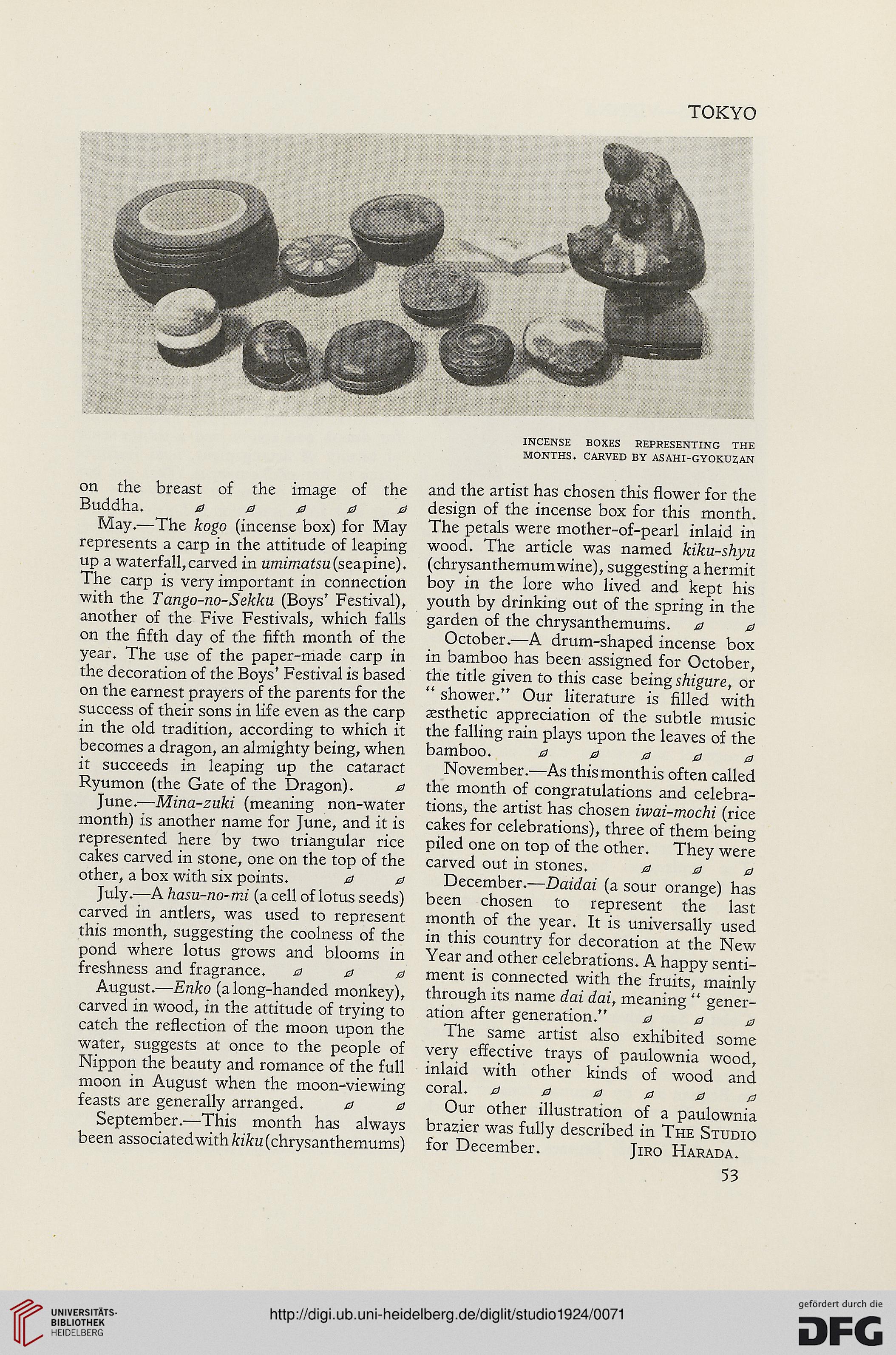TOKYO
INCENSE BOXES REPRESENTING THE
MONTHS. CARVED BY ASAHI-GYOKUZAN
on the breast of the image of the
Buddha. 00000
May.—The kogo (incense box) for May
represents a carp in the attitude of leaping
up a waterfall,carved in umimatsu(seapine).
The carp is very important in connection
with the Tango-no-Sekku (Boys' Festival),
another of the Five Festivals, which falls
on the fifth day of the fifth month of the
year. The use of the paper-made carp in
the decoration of the Boys’ Festival is based
on the earnest prayers of the parents for the
success of their sons in life even as the carp
in the old tradition, according to which it
becomes a dragon, an almighty being, when
it succeeds in leaping up the cataract
Ryumon (the Gate of the Dragon). 0
June.—Mina-znki (meaning non-water
month) is another name for June, and it is
represented here by two triangular rice
cakes carved in stone, one on the top of the
other, a box with six points. 0 0
July.—A hasu-no-mi (a cell of lotus seeds)
carved in antlers, was used to represent
this month, suggesting the coolness of the
pond where lotus grows and blooms in
freshness and fragrance. 000
August.—Enko (along-handed monkey),
carved in wood, in the attitude of trying to
catch the reflection of the moon upon the
water, suggests at once to the people of
Nippon the beauty and romance of the full
moon in August when the moon-viewing
feasts are generally arranged. 0 0
September.—This month has always
been associated with kiku (chrysanthemums)
and the artist has chosen this flower for the
design of the incense box for this month.
The petals were mother-of-pearl inlaid in
wood. The article was named kiku-shyu
(chrysanthemumwine), suggesting a hermit
boy in the lore who lived and kept his
youth by drinking out of the spring in the
garden of the chrysanthemums. 0 0
October.—A drum-shaped incense box
in bamboo has been assigned for October,
the title given to this case being shigure, or
“ shower.” Our literature is filled with
sesthetic appreciation of the subtle music
the falling rain plays upon the leaves of the
bamboo. 00000
November.—As thismonthis often called
the month of congratulations and celebra-
tions, the artist has chosen iwai-mochi (rice
cakes for celebrations), three of them being
piled one on top of the other. They were
carved out in stones. 000
December.—Daidai (a sour orange) has
been chosen to represent the last
month of the year. It is universally used
in this country for decoration at the New
Year and other celebrations. A happy senti-
ment is connected with the fruits, mainly
through its name dai dai, meaning “ gener-
ation after generation.” 000
The same artist also exhibited some
very effective trays of paulownia wood,
inlaid with other kinds of wood and
coral, 00000 0
Our other illustration of a paulownia
brazier was fully described in The Studio
for December. Jiro Harada.
53
INCENSE BOXES REPRESENTING THE
MONTHS. CARVED BY ASAHI-GYOKUZAN
on the breast of the image of the
Buddha. 00000
May.—The kogo (incense box) for May
represents a carp in the attitude of leaping
up a waterfall,carved in umimatsu(seapine).
The carp is very important in connection
with the Tango-no-Sekku (Boys' Festival),
another of the Five Festivals, which falls
on the fifth day of the fifth month of the
year. The use of the paper-made carp in
the decoration of the Boys’ Festival is based
on the earnest prayers of the parents for the
success of their sons in life even as the carp
in the old tradition, according to which it
becomes a dragon, an almighty being, when
it succeeds in leaping up the cataract
Ryumon (the Gate of the Dragon). 0
June.—Mina-znki (meaning non-water
month) is another name for June, and it is
represented here by two triangular rice
cakes carved in stone, one on the top of the
other, a box with six points. 0 0
July.—A hasu-no-mi (a cell of lotus seeds)
carved in antlers, was used to represent
this month, suggesting the coolness of the
pond where lotus grows and blooms in
freshness and fragrance. 000
August.—Enko (along-handed monkey),
carved in wood, in the attitude of trying to
catch the reflection of the moon upon the
water, suggests at once to the people of
Nippon the beauty and romance of the full
moon in August when the moon-viewing
feasts are generally arranged. 0 0
September.—This month has always
been associated with kiku (chrysanthemums)
and the artist has chosen this flower for the
design of the incense box for this month.
The petals were mother-of-pearl inlaid in
wood. The article was named kiku-shyu
(chrysanthemumwine), suggesting a hermit
boy in the lore who lived and kept his
youth by drinking out of the spring in the
garden of the chrysanthemums. 0 0
October.—A drum-shaped incense box
in bamboo has been assigned for October,
the title given to this case being shigure, or
“ shower.” Our literature is filled with
sesthetic appreciation of the subtle music
the falling rain plays upon the leaves of the
bamboo. 00000
November.—As thismonthis often called
the month of congratulations and celebra-
tions, the artist has chosen iwai-mochi (rice
cakes for celebrations), three of them being
piled one on top of the other. They were
carved out in stones. 000
December.—Daidai (a sour orange) has
been chosen to represent the last
month of the year. It is universally used
in this country for decoration at the New
Year and other celebrations. A happy senti-
ment is connected with the fruits, mainly
through its name dai dai, meaning “ gener-
ation after generation.” 000
The same artist also exhibited some
very effective trays of paulownia wood,
inlaid with other kinds of wood and
coral, 00000 0
Our other illustration of a paulownia
brazier was fully described in The Studio
for December. Jiro Harada.
53




